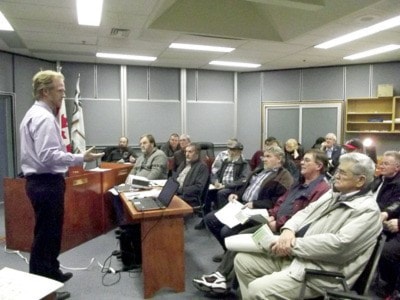As aging infrastructure fails, many western Canadian cities, towns and regional governments are looking at investing into treatment of their sewage in new ways that are more environmentally sensitive. One such community is the District of Barriere who recently received a grant from Canada’s Gas Tax Fund of $6.7 million to install a waste water system for the downtown core.
In preparation for the project, the district held an information session that was open to the public on January 24. Dave Underwood from TRU Consulting, and Patrick Meyer, Chief Operations Officer for Eco-Tek, presented an overview and answered questions about the proposed solar aquatics wastewater treatment system that will be built in downtown Barriere during the coming months.
Underwood outlined the four major components of the system: the wastewater collection system, the septage receiving facility, the treatment plant, and the effluent discharge. He then turned the meeting over to Meyer, who went into detail for the approximately 35 people in attendance about the third component - the treatment plant.
A solar aquatics system (SAS) treats raw sewage and other wastewater with biological methods using plant and bacterial life. The process produces no foul odour, uses no chemicals, and treats everything that comes into the facility, both liquids and solids.
The Solar Aquatics System is designed to duplicate the natural purifying processes of streams and wetlands within a climate controlled, regionally-appropriate solarium, greenhouse, or shade house.
The tertiary sewage treatment process is typically completed in two to four days during which contaminants are metabolized and bound up and complex organic compounds (such as fats, proteins and starches) and certain inorganic compounds are transformed into simple soluble compounds and biomass.
Within the Solar Aquatics System ammonia is oxidized into nitrate by nitrifying bacteria and is directly metabolized by algae and higher plants. While algae and plants metabolize nutrients, snails and zooplankton graze on solids.
The small amount of solids that remain at the end of the system are the active colonies of bacteria which are then pumped to the front of the system to aid in the treatment of the new sewage coming into the system.
There is no waste. Nothing needs to be trucked away, whereas conventional treatment is smelly, uses chemicals, and often requires trucking solids to landfill or composting.
It was noted during the session that close to 235 properties will be within the one mile radius around the fire hall where the system will be situated, with the first phase of the treatment system going as far as the Petro station. The district also has plans for a future phase two that will go as far as the Esso station, but that has no dedicated time frame at this time.
Those in attendance were told that as soon as the snow melts phase one will start with land surveys in the area.
Question time produced a lot of good questions from those in attendance, and for the most part residents seem to be all in favour of installing this state of the art system. The district noted that the grant received will cover the cost of the bringing the system to property lines, and it will be at the homeowners cost to hook into the system.
The district also assured citizens that there will be more public information sessions as decisions are made and planning can be brought forward.
Eco-Tek was established 1992 by Kimron Rink to promote social, ecological and economic sustainability in communities; creating sustainable ”planetary villages” using ecological technologies. They presently focus on sewage treatment utilizing Solar Aquatics Systems™ and other ecologically engineered technologies. Water and nutrient reclamation has been the team’s focus since 2005 utilizing these constituents to grow bio-regionally appropriate, regenerative plant material.
ECO-TEK incorporates cutting edge sustainable building principles into every project. Sustainable design and construction results in solar heated, low energy, heat recovering solariums for the Solar Aquatics System.
ECO-TEK’s website says they are the leader in ecological water reclamation in Canada, and although their focus has been on western Canada they have experience abroad as well. They have projects similar to the one that will be constructed in Barriere in Chrsitina Lake, B.C., Cynthia, Alberta, Erington, B.C., and Havana, Cuba.
If you would like to learn more about Eco-Tek go to their website: www.ecotek.ca.
